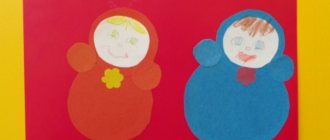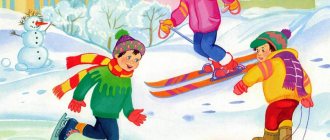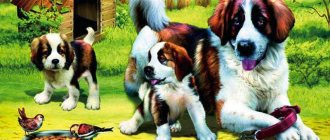The main goal pursued by plot pictures for composing a short story is the desire to develop the speech and thinking of children. Looking at the picture, the guys try to describe what is depicted on it, trying to compile a single, logically coherent story. Unfortunately, the speech of today's young people is far from perfect. Children and teenagers read and communicate little. Therefore, family, teachers, and all adults surrounding the child should pay attention to the development of correct literary speech. There are a huge number of ways to do this.
How can they be used?
One of them, already mentioned, is pictures for making a short story. On our website you will find story pictures for children. It is extremely important that the images are subordinated to a single theme, which means that the child, looking at them, will be able to compose a coherent message or play role-playing games for preschoolers. It is not for nothing that when teaching a foreign language, students are asked to describe a picture, come up with a dialogue according to the presented situation, and create role-playing games. This technique is also applicable when teaching the native language in a kindergarten or aesthetic center. You can download illustrations for writing a short story and print them for work.
The technique for developing speech based on pictures for composing a short story is simple. We advise parents to play role-playing games with their baby, lay out illustrations in front of him, and come up with a story together, a story in which the baby’s family or friends will be involved. Make sure that when describing, the child does not jump from one action or object to another, but expresses his thoughts consistently and logically. Having conducted such a lesson once, return to the worked picture after a while: ask the child if he remembers the story he compiled, what details he did not take into account, what he could add. A series of plot pictures for composing a short story are good for lessons on speech development in primary school, in native or foreign language lessons. Descriptions of illustrations, role-playing games, and a story based on them can be a good basis for creative work. Usually children respond with pleasure to such tasks, since children's imagination has not yet taken root, its flight is free and unhindered.
The method of working with pictures for children will require attention and regular practice from parents. It is the family that should be interested in the development of the baby. They should help him create a story, role-playing games for preschoolers, and then discuss them together.
A series of pictures for kindergarten or home use for children are focused on different topics. For example, you can compose a story on the topic “Family”, “Seasons”, “Forest”, “Home”, etc. The methodology for developing speech for children involves comprehensive coverage of topics on which a story can be compiled. The technique also involves the use of games for kindergarten, which will contain illustrations or a story on the chosen topic. As a result of a series of such activities, children begin to speak much more coherently, logically, and a single thread can be traced in their speech.
LiveInternetLiveInternet
Quote from Tatyana57
Read in full In your quotation book or community!
WE TEACH CHILDREN 5-6 YEARS OLD TO RELL, COMPLETE STORIES FROM PICTURES.
Retelling the story “A Rich Harvest” using plot pictures.
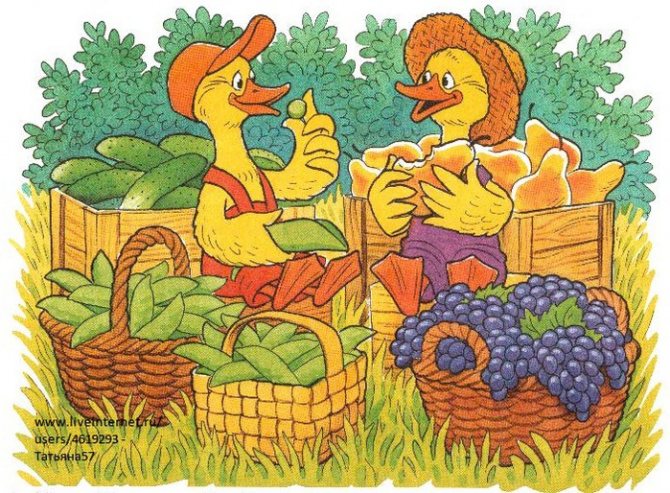
1.Reading a story. A bountiful harvest. Once upon a time there lived hardworking goslings Vanya and Kostya. Vanya loved to work in the garden, and Kostya loved to work in the vegetable garden. Vanya decided to grow a crop of pears and grapes, and Kostya decided to grow a crop of peas and cucumbers. Vegetables and fruits have grown wonderfully. But then insatiable caterpillars began to eat Kostya’s harvest, and noisy jackdaws got into Vanya’s garden and began pecking at the pears and grapes. The goslings were not at a loss and began to fight the pests. Kostya called the birds to help, and Vanya decided to make a scarecrow. At the end of summer, Kostya and Vanya harvested a rich harvest of vegetables and fruits. Now they were not afraid of any winter. 2. Conversation. - Who is this story about? — Where did Vanya like to work? What can it be called? — Where did Kostya like to work? What can it be called? — What did Vanya grow in the garden? - What’s in Kostya’s garden? - Who interfered with Vanya? Who is Kostya? —What can you call caterpillars and jackdaws? — Who helped Vanya get rid of the caterpillars? - What did Kostya do to scare away the jackdaws? — What did the hardworking goslings rejoice at at the end of summer? 3.Retelling the story. Retelling the story “Swans” using plot pictures.
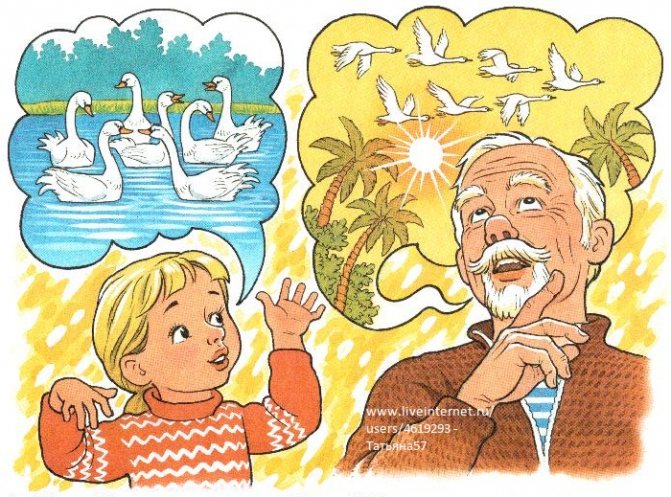
1.Reading a story. Swans. Grandfather stopped digging, tilted his head to the side and listened to something. Tanya asked in a whisper: “What’s there?” And grandfather answered: “Do you hear the swans trumpeting?” Tanya looked at her grandfather, then at the sky, then again at her grandfather, smiled and asked: “So, do swans have a trumpet?” Grandfather laughed and answered: “What kind of pipe is there?” They just scream so long, so they say they are blowing trumpets. Well, do you hear? Tanya listened. Indeed, somewhere high up, drawn-out, distant voices were heard, and then she saw the swans and shouted: “I see, I see!” They fly like a rope. Maybe they will sit somewhere? “No, they won’t sit down,” said grandfather thoughtfully. - They fly away to warmer climes. And the swans flew further and further. 2. Conversation. - Who is this story about? -What was grandfather listening to? - Why did Tanya smile at her grandfather’s words? - What does “swans trumpet” mean? - Who did Tanya see in the sky? - What did Tanya really want? - What did grandfather answer her? 3.Retelling the story. Compiling the story “How the Sun Found a Shoe” based on a series of plot paintings.
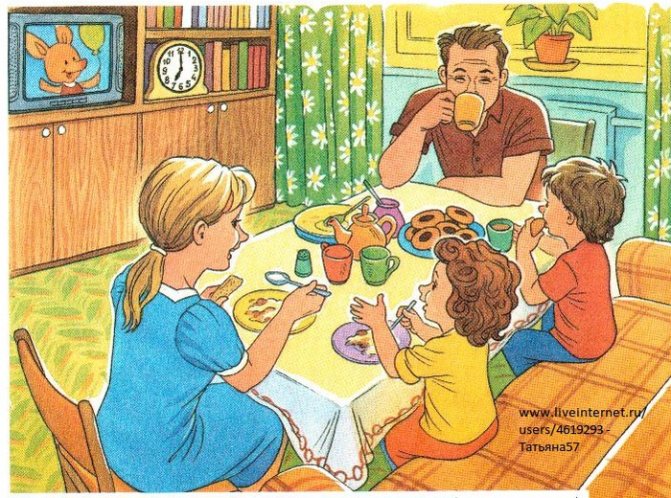
1. Conversation on a series of paintings. — What time of day do you think is shown in the pictures? - Why do you think so? — Where did Sasha and Masha come home from? -Where did dad and mom come from? — What is the name of the evening meal in the family? - What did mom do? For what? — What work does Sasha do? — What can you cook from potatoes? - What is Anya doing? - What will she do? — Who didn’t you see in the kitchen at work? — What kind of work did dad do? — When everything was ready, what did the family do? - How can we finish our story? — What do you think parents and children will do after dinner? - What can we call our story? 2. Compilation of a story. Family dinner. In the evening the whole family gathered at home. Dad and mom returned from work. Sasha and Natasha came from school. They decided to cook a family dinner together. Sasha peeled potatoes for mashed potatoes. Natasha washed the cucumbers and tomatoes for the salad. Mom went into the kitchen, put the kettle on the stove and began to brew tea. Dad took the vacuum cleaner and cleaned the carpet. When dinner was ready, the family sat down at the table. Everyone was happy to see each other at a family dinner. 3.Retelling the story. Compilation of the story “New Year is on the threshold” based on a series of plot paintings.
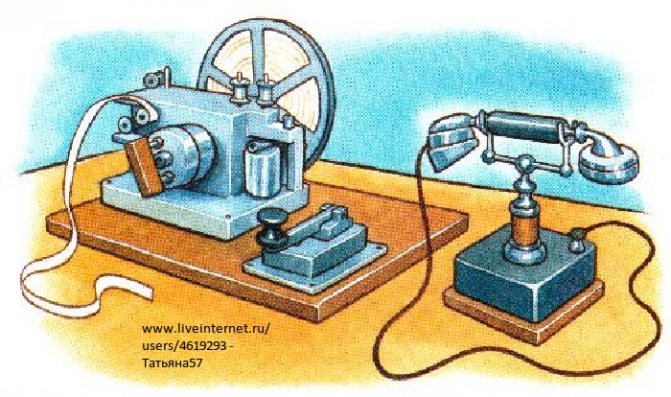
img src=/font
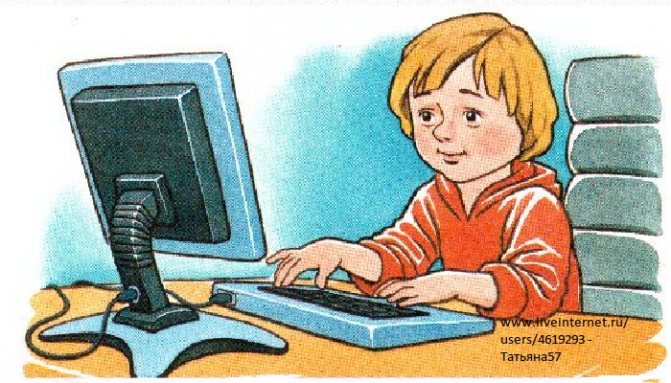
1. Conversation. — How do we communicate with each other if we are nearby? - And if a person is not nearby, then what do we do? — What can be classified as means of communication? — What can be sent by mail? — How was mail delivered before? — How did the telegraph work? — How long does it take now to send a message? - What do people use for this? — How does the postal service deliver letters and greeting cards to us? — Why do people write letters and greeting cards to each other? 2. Compilation of a story. How do we communicate? By talking, we communicate with each other. But sometimes a loved one is far away. Then telephone and mail come to the rescue. Having dialed the desired phone number, we will hear a familiar voice. And if you need to send a letter or a greeting card, you can go to the post office. Previously, mail was delivered on horseback. Then the Morse telegraph machine appeared, and messages began to be transmitted over wires using electric current. Engineer Bell improved the Morse machine and invented the telephone. Nowadays, messages with text and pictures can be transmitted very quickly. To do this, people use a cell phone and a computer. But even now people continue to write letters to each other, send greeting cards and telegrams by mail. Mail is delivered by car, rail or air. 3.Retelling the story. Compiling a story based on the plot painting “In a Living Corner.” 1. Conversation. -Who do you see in the picture? - Name the plants that are in the living corner. — Do children like to work in a living area? Why? -Who is working in the living area today? — What are Katya and Olya doing? — What kind of leaves does ficus have? — Why does Dasha like to take care of fish? What are they? — What should you do if a hamster lives in a living area? What is he like? — What birds live in the living area? —Where is the cage with the parrots? What parrots? — How do the guys do their work? — Why do they like to take care of animals and plants? 2. Compiling a story based on the picture. In a living corner. There are many plants and animals in the living area. Children enjoy watching and caring for them. Every morning when the children come to kindergarten, they go to the living corner. Today Katya, Olya, Dasha, Vanya and Natalya Valerievna are working in the living corner. Katya and Olya are caring for a ficus: Katya wipes its large shiny leaves with a damp cloth, and Olya waters the plant. Dasha likes fish: they are very bright and happily eat the food that she pours into the aquarium. Vanya decided to take care of the hamster: he cleans its cage and then changes the water. Natalya Valerievna feeds motley parrots. Their cage hangs high and the kids can’t reach it. Everyone is very focused and trying to do their job well. 3.Retelling the story. Compiling the story “The Hare and the Carrot” based on a series of plot paintings. 1. Conversation on a series of paintings. — What time of year is shown in the picture? — What can you say about the weather? - How much does a snowman cost? -Who ran past the snowman? -What did he notice? - What did the bunny decide to do? - Why couldn’t he get the carrot? - What did he plan to do next? — Did the ladder help him get to the carrot? Why? — How has the weather changed compared to the first picture? — What can you say about the mood of the bunny in the second picture? - What's going on with the snowman? — How does the sun shine in the third picture? -What does a snowman look like? — What is the bunny’s mood? Why? 2. Compilation of a story. Hare and carrot. Spring has come. But the sun rarely peeked out from behind the clouds. The snowman that the children made in winter stood there and didn’t even think about melting. One day a bunny ran past the snowman. He noticed that the snowman had a tasty carrot instead of a nose. He started jumping up and down, but the snowman was tall and the bunny was small, and he couldn’t get the carrot. The bunny remembered that he had a ladder. He ran into the house and brought a ladder. But even she didn’t help him get the carrots. The bunny became sad and sat down next to the snowman. Then the warm spring sun peeked out from behind the clouds. The snowman slowly began to melt. Soon the carrot ended up in the snow. The joyful bunny ate it with pleasure. 3.Retelling the story. A retelling of the fairy tale “Spikelet” using a series of plot paintings. 1.Reading a fairy tale. 2. Conversation. - Who is this fairy tale about? — What did the little mice do all day? - What can you call the mice, what are they like? And the cockerel? - What did the cockerel find? - What did the little mice propose to do? - Who threshed the spikelet? — What did the little mice propose to do with the grain? Who did it? - What other work did the cockerel do? - What were Krut and Vert doing at that time? — Who was the first to sit down at the table when the pies were ready? — Why did the little mice’s voices become quieter after each question from the cockerel? - Why didn’t the cockerel take pity on the mice when they left the table? 3.Retelling a fairy tale. Compiling the story “Where the bread came from” based on a series of plot paintings.
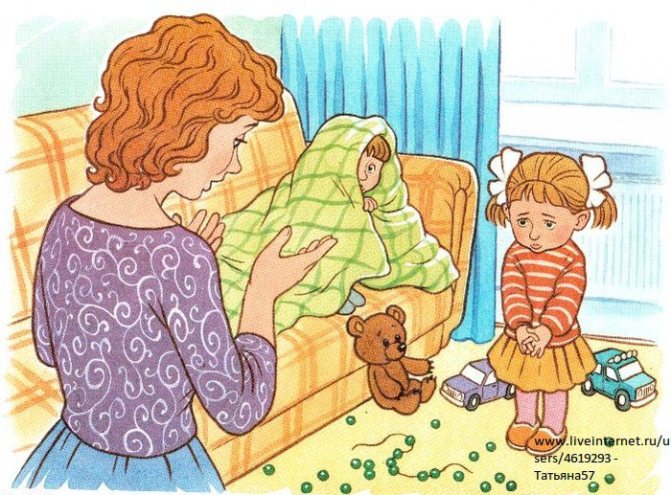
1. Conversation. — Who do you see on the go-kart? — What toys do you see in the picture? —Which child likes to play with a teddy bear? Who's with the cars? - How is mommy in the mood? What is she unhappy about? - When could this happen? -Where do you think mom went? -Who was left at home alone? What did the children promise their mother? — What was Katya doing? And Vova? —Whose beads are scattered on the floor? - Do you think mom allowed me to take the beads? -Who took them? — Why were the beads torn? — How did the children feel when their mother returned? 2. Compilation of a story. Alone at home. Mom went to the store to do some shopping. And Katya and Vova were left at home alone. They promised mom that everything would be fine. Katya took her favorite bear and began to tell him a story, and Vova played with cars. But suddenly Katya saw her mother’s beads. She really wanted to try them on. She took the beads and began to try them on. But Vova said that mother did not allow Katya to touch them. Katya did not listen to Vova. Then Vova began to remove the beads from Katya’s neck. But Katya didn’t let them take them off. Suddenly the thread broke and the beads scattered on the floor. At this time, mom returned from the store. Vova hid under the blanket out of fear, and Katya stood and looked guiltily at her mother. The children were very ashamed that they had not kept their promise. 3.Retelling the story. Compiling the story “The Border of the Motherland is Locked” based on a series of plot paintings.
Developmental materials on the topic
Kindergarten
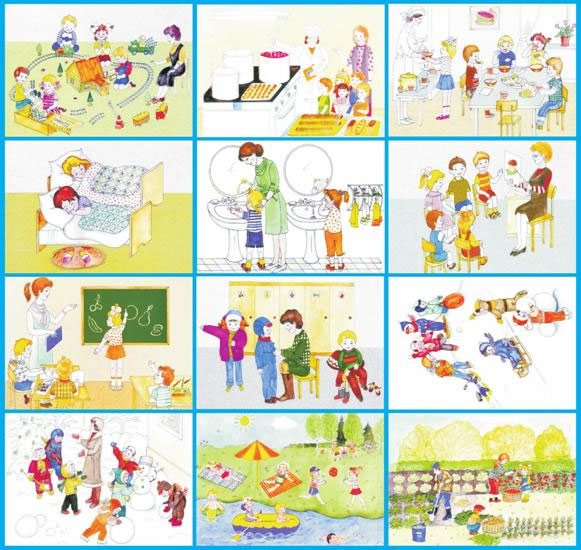
Pictures on different topics
Teaching preschoolers how to work with a series of pictures
At this stage, the training sequence is as follows:
- laying out the picture in one line from left to right;
- finding the main characters and common objects and phenomena in all pictures;
- determining the location of action in each picture and establishing connections based on an analysis of the location of characters and objects;
- determining the time of events in each picture (time of year, time of day);
- highlighting cross-cutting characters, naming their actions and leading to thoughts about the goals of their actions (why does he do this?);
- establishing a sequence of actions (what comes first, what comes next?);
- compiling a coherent story based on the laid out series.
A story based on a series of plot paintings according to plan
- Once upon a time... in such and such a place... such and such a character (name him)... did such and such in order to...
- Then he did (look at story 2)….
- Similarly, for each frame we encourage the child to talk about the character, his actions and goals.
- Summing up, conclusions. In the end it turned out..., so we can say that he (name the character) is so-and-so.
- Coming up with a title for the resulting story.
A series of pictures for storytelling. Theme "The Tale of the Hedgehog" based on the story by V. Suteev
(Image is clickable and opens in a new tab)
In the future, you can supplement the compiled story. It is important not to force the child to work according to plot pictures, but to include this activity in the game plot. You can invite your child to tell an interesting story to their favorite doll or bear. You can pre-select riddles or short poems that are consistent in theme with the plot of the series of paintings.
Another option for developing coherent speech is the use of paintings by famous artists. The page contains an album with a selection of paintings and descriptive texts.
